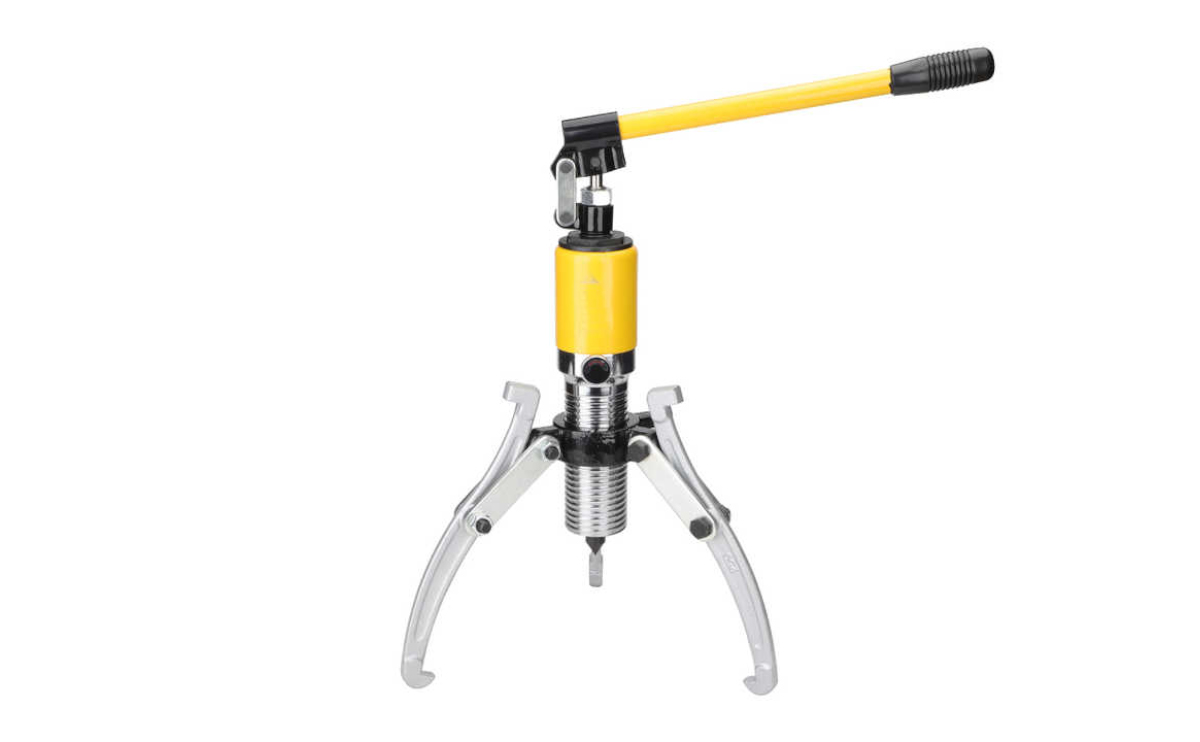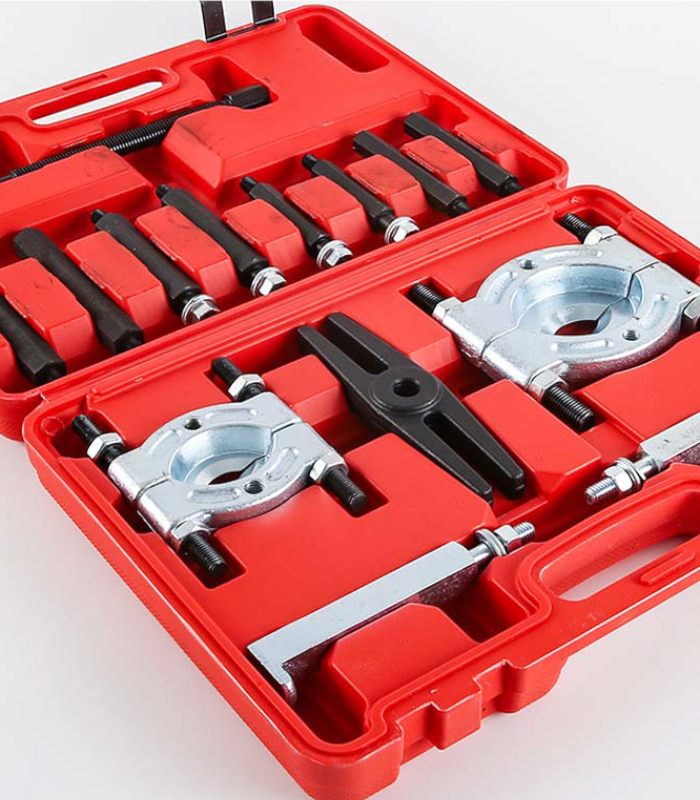How to properly select and use a bearing puller

A bearing puller is a device for removing an inner bearing from a bearing housing and is an inner bearings puller that includes a mounting plate, a tension bolt, and a through-wire bolt.
Table of Contents
Use of Bearing Puller
Bearing pullers are geared towards mounting and replacing bearings and are specifically designed for mounting and dismounting bearings from a wide range of machinery.
Choose the right puller, don’t waste time fishing because of the wrong size: Different sizes of bearings choose different bearing pullers. First, look at the bearing model number marked on the side of the bearing and select the bearings puller according to the bearing model number. Upon receipt of the bearings puller, you should check that all parts of the puller are in good condition.
Wash the surface of the bearing to be replaced. The bearing surface should be clean, dry, and free of lubricant.
Align the puller’s jaws with the outer race of the bearing to ensure that the jaws grip the bearing securely.
Follow the video.
Gently pull the puller apart while maintaining even pressure on both jaws. The bearing should begin to come out with minimal resistance.
Simple and easy to use bearing puller

Bearing Puller vs. Bearing Press: Which is Right for You?
When bearings need to be replaced, they are often faced with the daunting task of dismantling them without causing damage or stripping the surrounding material.
That’s why specialized disassembly tools are needed, and that’s where the bearings puller and Bearing Press come into play, handy tools designed to safely remove bearings from their housings.
But which tool should you choose? The bearings puller is ideal for standard mounting configurations, while the Bearing Press is suitable for applications that require special mounting or complex bearing arrangements.
The bearing puller makes it simple to remove the bearing from the mounting without damaging the surrounding material. The tool usually has an adjustable lever or clamp, typically two or three jaws, allowing the operator to apply force to the bearing, ensuring a clean removal process. Bearing Press, on the other hand, applies compressive force directly to the bearing to remove it.
The bearing puller is often preferred in applications where accuracy and control are critical, such as when dealing with precision bearings or sensitive equipment, while the Bearing Press is used where special mounting or complex bearing arrangements are required, and where the bearing inner ring or shaft is large enough to allow the bearing to be pulled out.
Advantages of the bearing puller: The bearing puller allows for precise human-operated control of the removal process, allowing the operator to maneuver slowly enough and accurately enough not to cause damage. Adjustable levers or clamps will enable the user to fine-tune the method and adapt to a variety of installation situations.
Bearing Press Advantage: Bearing Presses are used in situations where more forceful removal is required, which may require specialized mounting or complex bearing arrangements. Hydraulic or pneumatic systems used in the press can significantly reduce dismantling times.
Should you choose a bearing puller or a Bearing Press? Certain types of bearings, such as large or heavy bearings, may require the use of a Bearing Press for safe removal. For small bearings or standard mounting configurations, the bearing puller is often preferred, while the Bearing Press excels in applications that require special mounting or complex bearing arrangements.
Common bearing puller specifications and their parameter introduction.
KP0-20 bearing puller: suitable for bearing dismantling with inner diameter of 8-20mm, pulling force is 20KN, working environment temperature is -30℃~+100℃.
Kukko22-1 bearing puller: suitable for dismantling bearings with inner diameters of 8-16mm, pulling force of 10KN, working environment temperature of -30℃~+100℃.
DM-10A bearing puller: suitable for bearing dismantling with an inner diameter of 8-15mm, pulling force of 10KN, adjustable handle, easy to use, the working temperature of -20℃~+50℃.
CSLK160 bearing puller: suitable for bearing dismantling with inner diameter of 30-160mm, pulling force of 160KN, with double insurance device, working environment temperature of -20℃~+50℃.
D-50 bearing puller: suitable for bearing dismantling with inner diameter of 10-50mm, pulling force of 10KN, used in conjunction with handle, working environment temperature of -20℃~+50℃
Common mistakes to avoid when using bearing pullers.
Inadequate lubrication is a common cause of premature bearing failure. Similarly, if your instrument is costly and delicate, using a bearing puller without adequate lubrication can cause friction between the tool and the bearing, resulting in scoring and possible damage to the bearing or surrounding components, affecting its performance.
Therefore, it is important to always apply the proper lubricant to the bearings before the bearing puller is used. The type of lubricant used depends on the specific application and the materials involved. Common lubricants include grease, oil, or specialized bearing grease. It is important to follow the manufacturer’s lubrication recommendations when using a specific tool.
Choosing the correct type of bearing puller is critical to avoiding bearing damage; don’t be a brute force. Different types of bearing pullers are designed for specific applications and may not be suitable for all bearings. For example, some bearing pullers are used for large or heavy bearings, while others can only be used on small or light bearings.
Another common mistake when using a bearing puller is overtightening or loosening. Over-tightening can lead to bearing damage or breakage. On the other hand, failing to tighten may cause the bearing to loosen and detach during use.
How to clean and lubricate bearings
Waiting for bearings to go bad is not a good idea, so why not avoid bearing damage, we should know how to clean and lubricate bearings. Especially some expensive bearings.
The vast majority of newly bought bearings are coated with grease. This grease is mainly used to prevent bearing rust, and does not play a lubricating role, therefore, must be thoroughly cleaned to install and use. The cleaning method is: Where bearings are sealed with anti-rust oil, they can be cleaned with gasoline or kerosene.
Old bearing cleaning: you need the right cleaning agent, do not use water as it may cause the bearing to rust. Common choices are acetone (nail polish remover) or 90%+ topical alcohol. I’m not recommending any cleaners to you, you can choose your own.
Bearings are divided into two types of open seals—rubber seals and metal shields, either way, they can be easily removed using a small screwdriver.
Fill the bowl with cleaner (depending on the bearing’s size, they need to be submerged), lay the bearings flat, stop for a few minutes, and let them soak for a few minutes.
Remove them from the cleaning solution, place them on a towel or cardboard, lay the bearings flat, and wait for them to dry.
While the bearings are waiting to dry, we need to clean the seals. This is much easier to do by rinsing them in a cleaning solution. Then let them dry with the bearings.
Once the bearings are completely dry it is time to apply lubricant, you will need to apply lubricant to the bearings, to the balls, but not too much.
Once the bearings are dry, put the seals back on. Rub a little lubricant around the seals to prevent rust.
Automotive Rear Wheel Bearing Damage Symptoms, Causes and Testing
With the development of the times, driving is more and more people, and bearings are also important parts of the car, such as car wheels, and the engine bearings the use driving will not necessarily understand the symptoms of damage to the parts, let’s take a look at some knowledge about the car wheel bearings.
There is a car repair driver said to the car repair master: “This vehicle in the startup, stationary are very normal, but once the vehicle begins to drive, the noise will be much larger, especially when accelerating the noise is particularly noticeable, the faster the speed, the greater the noise, the noise of the headache, is not the engine out of the problem?” It’s not all.
After the car repair master detection, concluded: that the vehicle engine and transmission were normal, found that the car’s rear wheel bearing was damaged phenomenon.
In response to this phenomenon, China Bearing Network to share the relevant automotive rear wheel bearing damage symptoms, bearing damage causes, and how we check whether the wheel bearing damage some knowledge, I hope that the majority of friends who love the car will help, to travel safely, the vehicle such as faults we find as early as possible, timely processing.
The performance of the car’s rear wheel bearing is bad:
Causing noise is the main manifestation of the car’s rear-wheel bearing being bad. To determine whether the rear wheel bearing is bad, you can speed up the car to the state of the neutral gear coasting, if the buzzing sound does not change, then it is the rear wheel bearing is bad. If it is bad, it will produce a lot of heat, you can drive the car for some time, parked on the side of the road, with a hand to touch and feel the wheel hub axle, can feel its temperature is significantly higher than the normal temperature. Another point is that when the car speed is faster, you can feel the bottom of the foot has a fine sense of vibration.
Several main reasons lead to damage to the rear wheel bearings of a car:
The breakage of parts rust, there is the entry of foreign objects or roller ladder deflection will cause breakage, and acidic liquid and moisture residue for a long time, will also cause the rust of parts.
Poor lubrication, if there is insufficient lubricating grease between the roller body and the raceway, the two will produce dry friction, resulting in a metal friction noise.
Distance problem. There is a suitable clearance between the parts and components of the car, and when the distance between the roller body and the roller raceway is once small, it is easy to friction and heat, causing bearing sintering.
Regarding the inspection of automobile wheel bearings, it is not complicated:
The first step is to lift the vehicle with a hoist so that the wheels are suspended and the handbrake is released;
In the second step, when testing the non-driven wheels, you can manually rotate the wheels from slow to fast to check whether there is any noise in the bearings;
In the third step, when testing the driven wheels, start the vehicle and let the wheels idle to check for any additional noise from the bearings.
There is also a special case to note that some bearing failures can not be heard just by idling the tires, and the car must be dropped on the ground to put the bearings under pressure to make an accurate judgment.
